Background
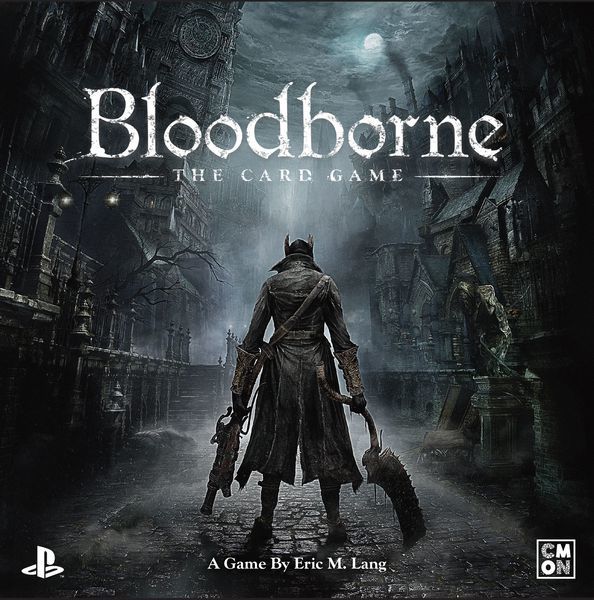
Earlier last month, I was scanning Amazon, as I am wont to do, looking for a new cooperative board game. With an ungodly number of Pandemic and Robinson Crusoe play-throughs under my belt, I was looking for something a bit more challenging. Don't get me wrong, Robinson Crusoe isn't exactly a cakewalk, but my board game group has played it to death, and I was looking for something new but in the same wheelhouse. Unfortunately, the vast majority of cooperative board games tend to aim for entry-level to intermediate audiences, and we are not that. After an exhaustive search, however, I discovered the Bloodborne card game adaptation from Eric M. Lang.
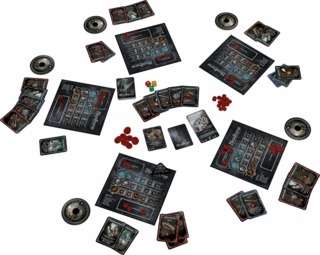
For those unaware, Eric M. Lang is a legendary designer in the board game industry. His credits include the universally beloved "Blood Rage" as well as the incredibly flashy "The Others." Lang is also a bit of a board game polymath. The man has worked with a variety of properties, both original and licensed, and has found success in several different mediums. While most are familiar with his work on Blood Rage, he has seen equal success at making card games. Throughout his career, Lang has designed collectible card games utilizing the Star Wars, Game of Thrones, Call of Cthulhu, and Warhammer properties. Finally, if there are any of you who enjoy playing Duelyst, you should be aware he was the game's lead designer.
I say all this to point out Eric Lang is a person to follow in the board game community. And yet, the release of his Bloodborne card game alluded me until three years after its release. I get I am not entirely in the loop when it comes to new board game releases, but I don't even recall seeing the thing at my brick and mortar card shop. Regardless, I bought it at the highly affordable rate of $22. The game has an expansion pack known as "The Hunter's Nightmare" which adds in more bosses and monsters. I should also mention a full-fledged Bloodborne board game adaptation is coming out sometime in 2020, though, this game is not without controversy in the board gaming community.
Even so, I get there's a bit of an "elephant in the room" before I continue this review. I know many of you see the words "card game" and immediately think of Magic the Gathering or any other trading card game. If that's you, rest assured, Bloodborne: The Card Game is a "drafting game" that does not require any investment outside of the base game. For those unaware, card drafting games are games in which players pick cards from a pool to gain an advantage over their fellow players. In the case of Bloodborne: The Card Game, players work "cooperatively" to survive a dungeon created through the random selection of monster and boss cards. With that mini-disclaimer out of the way, let's review the game's components.
Components
First off, Bloodborne comes in a small, tightly-packed, box. Even so, I did not struggle with organizing the game's components after several uses. These parts are as follows:
- 50 Five-Point Blood Echo Tokens
- 60 One-Point Blood Echo Tokens
- 1 First Player Token
- 15 Trophy Tokens
- 5 Hunter Dials
- 3 Custom Monster Dice
- 25 Hunter Starter Cards
- 32 Hunter Upgrade Cards
- 18 Chalice Dungeon Cards
- 7 Chalice Dungeon Boss Cards
- 5 Final Boss Cards
- 5 Hunter Boards
To some, this list might sound like a lot of elements, but in actuality, it isn't. Indeed, ease of set-up is one of the game's best aspects as it takes at most five to six minutes to prepare. First, you collect the Final Boss cards, shuffle them up and randomly select one. The final boss goes in the middle of the table, and their de-buff remains active for the entire session. Next, you prepare the Chalice Dungeon by first separating the boss and monster cards. You shuffle each deck and randomly select seven monsters and three bosses. After combing the two, to create a deck of ten cards, you again shuffle the cards and keep the order and identify of the cards a secret.
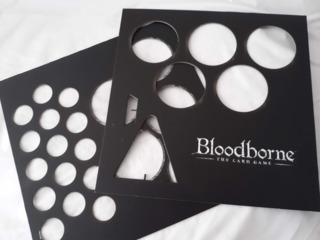
With the Chalice Dungeon finished, it's time to set up each player. First, you prepare the "Upgrade Deck" by shuffling it and turning over one upgrade card per player to make them available when the game begins. Second, each player takes a Hunter Board and places the appropriate Trophy Tokens on their respective spots. Afterward, each player gets the same starting deck of equipment as well as a health dial. The health dials are set to eight unless a boss or monster reduces that number via a passive de-buff. Blood tokens go to the side, and players pick someone to go first and give them the "First Player Token." The game then starts after the first player turns over the first monster card in the Chalice Dungeon deck.
Before I address the mechanics, let's review the quality of the components. The components are perfectly acceptable for something I bought for $20 on Amazon. As such, if you are looking for high production values in this budget-priced card game, then you will be sorely disappointed. Nonetheless, even with realistic expectations, the game's corner-cutting is immediately noticeable. For one thing, you have to punch out every cardboard token from a prefabricated sheet. Admittedly, doing so saves money, and the symbols look nice, but this has always been a pet peeve of mine.
The rest of the components are incredibly inconsistent. The cards use modified screencaps from the video game. While that may sound off-putting to some, they of a high enough quality where they don't feel cheap. What does annoy me about the art style is its muted color palette. I understand this was a creative choice to mimic the video game's gothic art style. Be that as it may, the game asks you to keep track of a significant amount of iconography, and the almost monochromatic color scheme makes this a chore. As you can see in the gallery below, each monster or boss card has a health icon, color-coded difficulty lantern, trophy type, and ability. All of this information is jam-packed on a DARK standard-sized playing card! Luckily, the final bosses are on larger cards, but they are still dark and difficult to read especially when playing the game in larger groups.
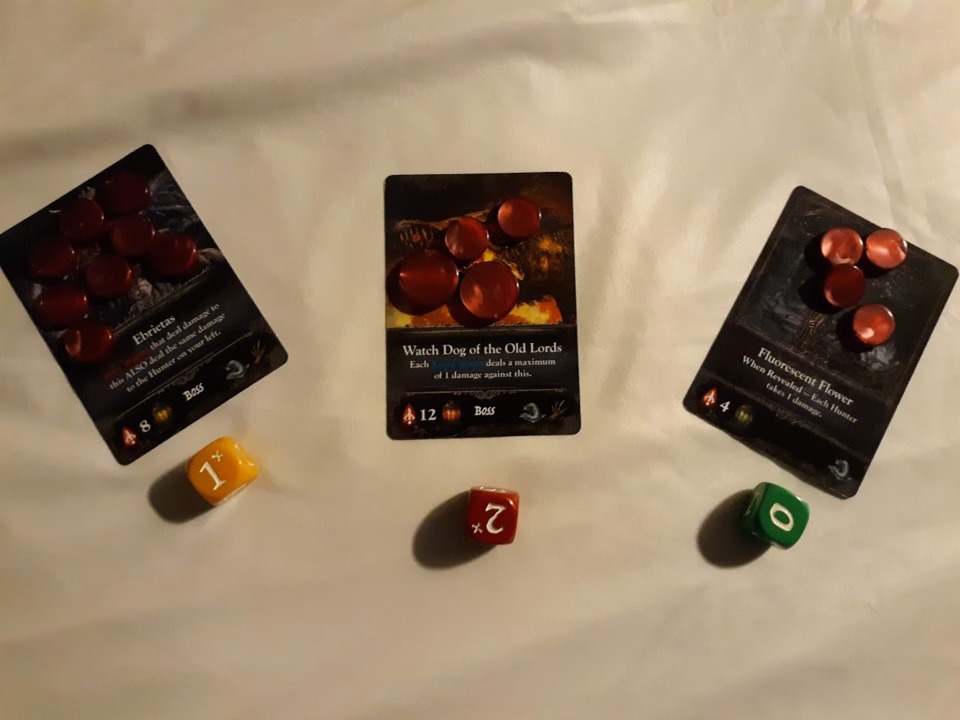
To make matters worse, a lot of the components are fiddly! The health dials are two pieces of cardboard attached using two plastic fasteners. Here, I would have preferred something similar to the health sliders from King of Tokyo. Also, the game asks you to place four sets of tokens on your player/hunter board. You have all three types of trophy tokens as well as any Blood Echos you manage to collect. With nothing holding these pieces in place, you are one ill-timed knee bump away from ruining your game. Then you have the custom dice which are color-coded to match the difficulty lanterns on the monster or boss cards. While the rest of the game features a muted color palette, these dice look like they came from the Crayola crayon factory. None of these issues are in and of themselves "deal breakers" so long as the game provides a fun and replayable experience. So, let's review how to play the game.
How It's Played
Bloodborne takes place over several rounds, each of which takes eight steps. The following steps occur during each round:
- Choose & Play Action Cards
- Transform Weapons
- Resolve Instant Effects
- Monster Attack Phase
- Hunter Attack Phase
- Monster Escape (if possible)
- The Hunter's Dream
- End Of The Round
Before the round starts, the first player turns over one card from the Chalice Dungeon deck and reveals it to the party. If the card has an "Instant Effect," this effect is immediately addressed before the round begins. Additionally, be aware, the passive buffs of the Final Boss apply throughout the game. Likewise, the first player places Blood Echos on top of the revealed card to match the monster's health. If you are playing with four players, the game asks you to add an extra Blood Echo, and two if you are playing with five. At the start of each round, players choose one of their action cards and reveal them to the party. The game asks you to keep your action cards concealed from the rest of the party, though open discussions are permitted.
If any players from the previous round chose the "Transform" card, they move to step two and can choose any melee or ranged weapon in their hand. Once action cards and weapons are selected, players resolve any "Instant Effects" associated with their cards. It is possible for your instant effects to KO the monster before the attack phase, and the game encourages you to take advantage of this opportunity whenever possible. Any Blood Echos you gain from instant effects transfer to the "Collected Blood Echos" section of your Hunter Deck.
If the monster is still alive, the round transitions into the "combat phase," and the monster card always attacks first. To determine how much damage they do, identify the color-coded die that matches the monster's difficulty lantern, and roll that die. If the number you roll has a plus symbol, continue rolling until you roll a number that does not have a plus symbol and add the sum of every number. The monster then does that sum of damage to every player, even those who have not yet attacked. If any players die, remove their non-banked Blood Echos, and return them to the pile. These players are out of play until the "Hunter's Dream" step. If a player opted to enter the "Hunter's Dream," they will only take half damage, but they will not be able to attack the monster.

Now, starting with the first player, review the blood icon on your weapon and begin removing that number of Blood Echos from the monster or boss. For example, the "Saw Cleaver" inflicts one point of damage. Start with the first player and then move clockwise while skipping any "dead" hunters. Any Blood Echos you remove from monsters are stored on your Hunter Deck and are worth points. Be aware, some action or weapon cards take effect after a monster attacks or dies. To illustrate, the "Saw Spear" inflicts extra damage for each point of damage you take when a monster attacks.
If the monster dies, any player that dealt it damage gains a trophy and moves their matching trophy icon accordingly. On the other hand, if the beast is alive after every player attacks, it escapes and inflicts a negative status effect if the card has one. Monsters labeled as bosses never escape, and the two combat phases repeat until either it or all players are dead. If you are fighting a boss for more than one round, instant effects do not happen more than once, though passive buffs still apply until the end of the combat phase. At the end of the combat phase, should the players be victorious, all cards used during the battle are discarded and placed next to the player who used them.
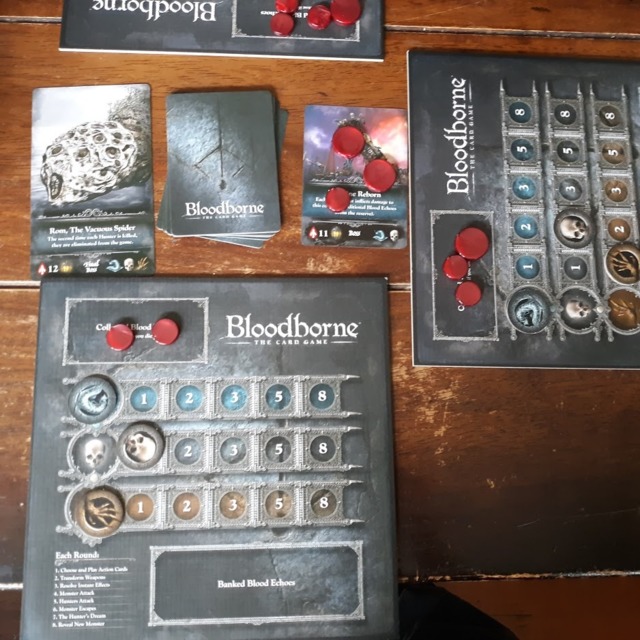
If the monster or boss is dead, you move into the game's final two steps. First, if any players used the "Hunter's Dream" card during the first step, they enter the "Hunter's Dream." As mentioned earlier, these players take half damage during battles, but cannot attack. After the battle is over, these players "bank" any previously collected Blood Echos and add these Blood Echos to their total score if the party defeats the Chalice Dungeon. Second, players can recollect any of their discarded action cards from previous rounds, including the "Hunter's Dream" card. Be aware; players can only have seven cards and can never abandon the "Hunter's Dream" card. Players also collect one available upgrade card and reset their health. Players who died in combat are revived and can obtain one upgrade card, though they are not able to recover their discarded equipment.
We now enter the "End of the Round" phase. As mentioned before, cards used to fight the previous monster are discarded until that player enters the "Hunter's Dream" phase and recollects them. Pass the first player token clockwise, and reveal the next monster. Repeat the previous steps, noting if a monster card has the "boss" moniker on it. If the standard Chalice Dungeon deck is complete, move to the Final Boss. If all Chalice Dungeon Cards, including the final boss, are defeated, the game is over. Count however many banked or collected Blood Echos you have and count them as one point. Next, combine this with however many trophies you have on your Hunter's Deck. Whoever has the highest total score is the winner.
Gameplay Impressions
Undoubtedly, Bloodborne: The Card game is not your "standard" cooperative card or board game. While it begins as a collective dungeon crawler; its competitive aspects inevitably lead to backstabbing and uneasy alliances. As such, it's crucial to note Bloodborne: The Card game is downright cruel. Several upgraded weapons not only inflict damage to both monsters but also to surrounding players. Likewise, every monster is capable of wiping your party out. Thus, it is safe to say you should NEVER play this game with total strangers! I tried it once, and it ruined my entire day because people pounced on the opportunity to be shitty.
Nonetheless, Bloodborne: The Card has several positive aspects worth mentioning. For one thing, you can finish the game in about thirty minutes, barring you avoid one of the final bosses. Furthermore, you never feel especially dejected, even after a team loss, as you can jump back into the game in a matter of minutes. Additionally, I LOVE the game's use of simultaneous play. There's no better feeling than playing a suit of cards and KO-ing a monster before it attacks. The card drafting element of the game is equally rewarding. I enjoyed having to plan which cards to use as my action and thinking strategically about which seven cards should be in my deck. Also, there's no denying the game's effective use of theme and the fact it leans into the video game's brutal reputation.
So why do I hate playing this game? The primary issue comes down to the "Hunter's Dream" mechanic. Usually, I'm okay with the idea of "banking" items or points as a mechanic. However, in the case of Bloodborne: The Card Game, you have to sacrifice an entire turn to perform this critical step. Consequently, with the game only taking up ten rounds, you end up "skipping" at least one-third of the combat to bank points. Worse, when you do enter the game's dream realm, you can set up unrecoverable death spirals. Especially when it comes to the boss encounters, dozens of battles require full cooperation between you and your party, and that is rarely possible with this mechanic.
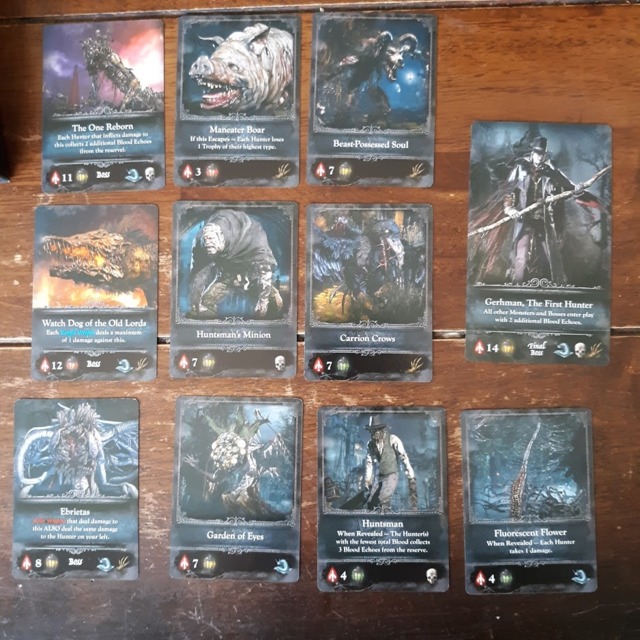
To illustrate this issue, let me share a situation that happened during one of my play sessions. When it was time to reveal our action cards, three of my party members elected to go into the dream world. The problem was we were about to fight a boss, and bosses do not run away — meaning, one other player and I were condemned to die! Worse, this happened on the last card before the final boss; thus, our party only had three out of five players during the ultimate battle. This scenario sucks, and it happens ALL THE FUCKING TIME! To add insult to injury, players regain the ability to enter the dream realm immediately after leaving. There's no hard cap on how often you can go there, and the result is few, if any players, have any motivation to avoid entering the realm after one or two turns. Sure there are trophies, but they are harder to get and of equal value to banked Blood Echos according to the scoring system.
Speaking of which, the scoring system is a shitshow! Not only does it exacerbate the game's brutal nature, but it's poorly balanced. To highlight the latter of these problems, I'll again refer to another play session of mine. The group this time around was fighting one last monster before the final boss. Up to this point, one of my party members had been perpetually in the lead. To be specific, they had thirty-one points. The total value of the last two matches was twenty-six points, with the final boss representing HALF the value of their overall score after NINE ROUNDS OF PLAY! To no one's surprise, they lost by six points.
Another issue comes in the game's use of critical damage (i.e., exploding dice). Every enemy, even the goons you fight in the very beginning, have a 33% chance of inflicting critical damage as two sides on every die have a plus symbol. In a game where there are bosses who can reduce your maximum health or items that cause chip damage to the person next to you, that's way too high. Here I can at least partially understand Eric Lang's thought process. At some point, he learned the bosses in Bloodborne can wipe out your player character in a single cinematic attack. However, that concept can be mitigated as you learn the animations and attack patterns of the bosses. Here, the dice have two sides that automatically inflict critical damage, and there's nothing you can do about it.

Finally, let's address the final bosses in the game. There are five, and that's not nearly enough. One of these bosses, Mergo's Wet Nurse, is meant to be an introductory confrontation if there's someone in your party who has never played the game. Likewise, there are two bosses I outright refuse to play. One, Rom, The Vacuous Spider, permanently eliminates any players who die twice. This rule is shitty and should not be in any game, let alone a semi-cooperative game that requires multiple players to complete. The other boss who sucks is Micolash who adds a new non-boss monster to the deck whenever a monster manages to escape. Micolash may well be my least favorite boss as he entirely ruins the game's quick and frenetic pace. Also, by the late stages of the game, it is inevitable players will remove themselves from combat and enter the "Hunter's Dream" phase, making escaping enemies a guarantee. The result is dungeons drag on far longer than they should.
Final Words
Part of me wants to give credit where credit is due. Eric Lang and his supporting cast at CMON Games have made a card game adaptation of Bloodborne which captures the spirit of the game perfectly. It's a dark and moody affair where everything is out to get you, including the people next to you. Likewise, the card game is perfectly paced and easy to jump into regardless of your experience with card or board games. The thirty-minute playtime is perfect, and most of the mechanics do not slow down the game's action-packed structure. Finally, the game's procedurally generated nature means it has a lot of replayability.
That said, I did not enjoy playing Bloodborne: The Card Game. Virtually each of its mechanics is designed to both frustrate and infuriate players. The cooperative elements mostly fall to the wayside, and you'll find yourself having to deal with an endless amount of backstabbing. On top of that, so much of the game stacks the deck against your favor; it's hard to think of an audience for this game. You can't play it with strangers as the game's innate meanness encourages people to act like shitheads. You will struggle to play it with veteran card and board gamers as the game's broken mechanics will immediately pull them out of the experience.
Before I end this mostly negative review, I do want to defend the game ever so slightly. Of the dozen or so play sessions I have taught this game, there has always been at least one person enamored by Bloodborne: The Card Game. Every time I play it, someone publicly says to me they plan to buy the game as soon as they can. Maybe, after reading this blog in its entirety, you are that person. If you think that may be you, have fun, and don't forget to pack an extra battleaxe.
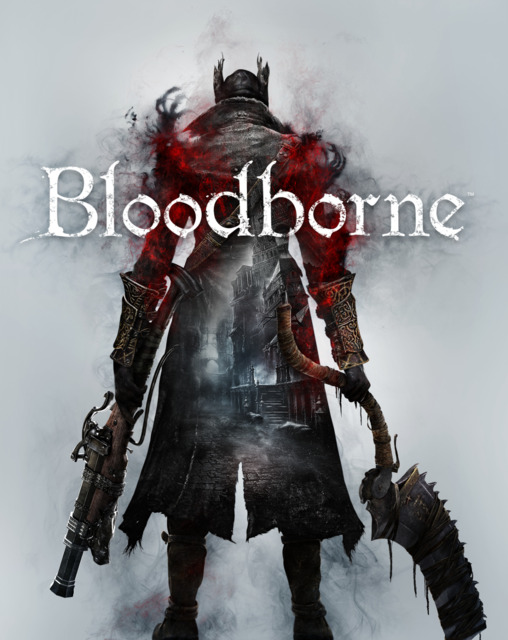
Log in to comment